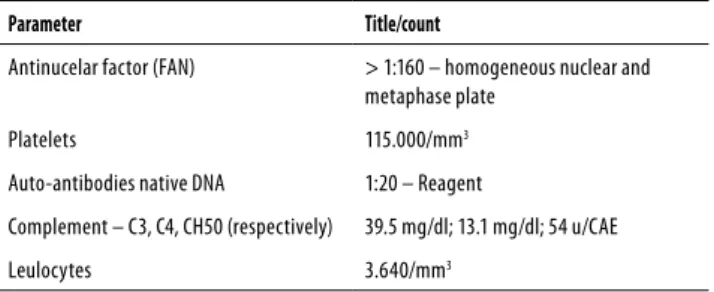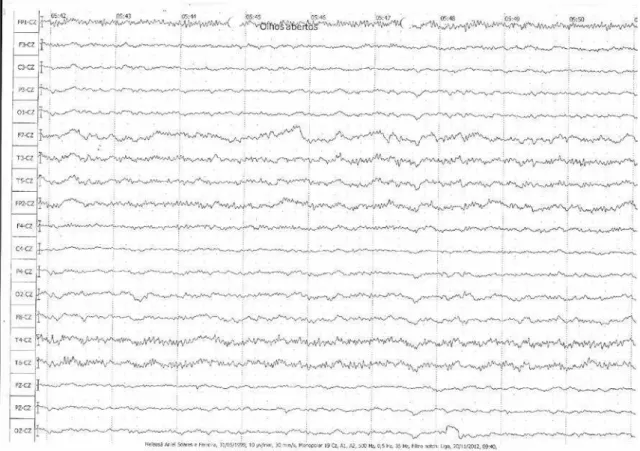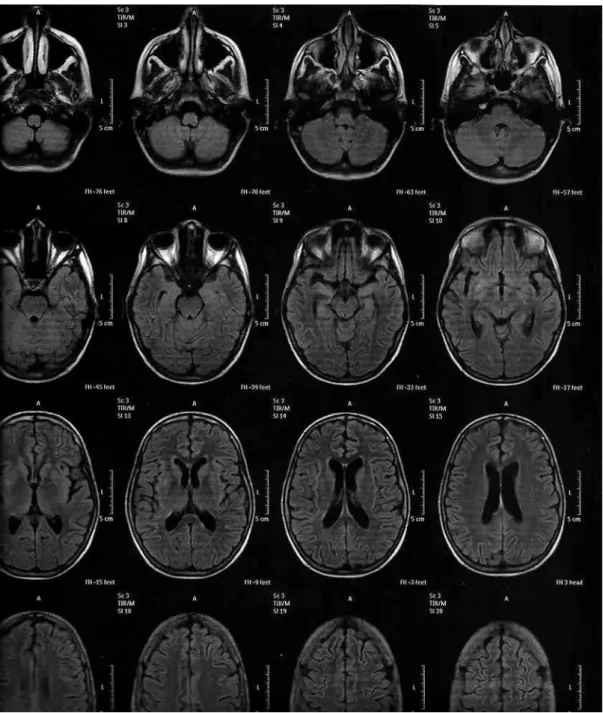Catatonia secundária a lúpus eritematoso sistêmico
Francisco de Assis Pinto Cabral Júnior Rabello
1, Daniel Calich Luz
1, Evânia Claudino Queiroga de Figueiredo
2,
Edmundo de Oliveira Gaudêncio
3, Larissa Cristina Queiroga Mendonça Coutinho
4, Waldeneide Fernandes de
Azevedo
5ABSTRACT
Objectives: Discuss neuropsychiatric aspects and diferential diagnosis of catatonic
syndro-me secondary to systemic lupus erythematosus (SLE) in a pediatric patient. Methods: Single
case report. Result: A 13-year-old male, after two months diagnosed with SLE, started to
present psychotic symptoms (behavioral changes, hallucinations and delusions) that evolved into intense catatonia. During hospitalization, neuroimaging, biochemical and serological tests for diferential diagnosis with metabolic encephalopathy, neurological tumors and neu-roinfections, among other tests, were performed. The possibility of neuroleptic malignant syndrome, steroid-induced psychosis and catatonia was also evaluated. A complete reversal of catatonia was achieved after using benzodiazepines in high doses, associated with immu-nosuppressive therapy for lupus, which speaks in favor of catatonia secondary to
autoim-mune encephalitis due to lupus. Conclusion: Although catatonia rarely is the initial clinical
presentation of SLE, the delay in recognizing the syndrome can be risky, having a negative impact on prognosis. Benzodiazepines have an important role in the catatonia resolution, especially when associated with parallel speciic organic base cause treatment. The use of neuroleptics should be avoided for the duration of the catatonic syndrome as it may cause clinical deterioration.
RESUMO
Objetivos: Discutir aspectos neuropsiquiátricos e o diagnóstico diferencial da síndrome
catatônica secundária a lúpus eritematoso sistêmico (LES) em paciente pediátrico.
Méto-dos: Relato de caso individual. Resultado: Adolescente do sexo masculino com 13 anos de idade iniciou, após dois meses de diagnosticado com LES, quadro psicótico (alterações comportamentais, alucinações e delírios) que evoluiu para franca catatonia. Durante inter-nação hospitalar foram realizados, entre outros, exames de neuroimagem, bioquímicos e sorologias para diagnóstico diferencial com encefalopatia metabólica, tumores neurológicos e neuroinfecções. Foi avaliada também a possibilidade de síndrome neuroléptica maligna, psicose e catatonia induzida por corticoides. Houve reversão completa da catatonia após o uso de benzodiazepínico em altas doses associado à terapia imunossupressora para o lúpus, o que fala a favor de uma catatonia secundária a uma encefalite autoimune de base lúpica.
1 Universidade Federal de Campina Grande (UFCG).
2 Universidade de São Paulo (USP). Universidade Federal da Bahia (UFBA). UFCG. 3 Associação Brasileira de Psiquiatria (ABP). Universidade Federal da Paraíba (UFPB), UFCG. 4 Hospital Universitário Alcides Carneiro, Campina Grande, PB, UFCG.
5 UFPB. Sociedade Brasileira de Pediatria (SPB). Universidade Estadual da Paraíba (UEPB), UFCG.
Endereço para correspondência: Francisco de Assis Pinto Cabral Júnior Rabello Rua Nilo Pacheco de Medeiros, 110, Santana
36880-000 – Muriaé, MG, Brasil E-mail: fco.psicossomatica@gmail.com
Received in 11/6/2013 Approved in
4/11/2014
Keywords
Catatonia, systemic lupus erythematosus, benzodiazepines, diferential diagnosis.
Conclusão: Apesar de a catatonia ser raramente apresentação clínica inicial do LES, o atraso no reconhecimento da síndrome pode ser arriscado, tendo impacto negativo no prognósti-co. Os benzodiazepínicos têm papel importante na resolução da catatonia, principalmente quando associada ao tratamento especíico em paralelo para a causa orgânica de base. O uso de neurolépticos deve ser evitado durante a vigência da síndrome catatônica, podendo agravar o quadro clínico.
Palavras-chave
Catatonia, lúpus eritematoso sistêmico, benzodiazepínicos, diagnóstico diferencial.
INTRODUCTION
Catanonia has been reported in the clinical spectrum of systemic lupus erythematosus neuropsychiatric (SLENP) manifestations. It represents a complex syndrome character-ized mainly by stupor, mutism, negativism, waxy lexibility, stereotypy, automatic obedience, echo phenomena
(inclu-ding echolalia and echopraxia)1. Catatonia can be caused
by a large variety of metabolic, neurologic, psychiatric and intoxication conditions, including neuroleptic malignant
syndrome2.Although catatonia as an expression of a pure
mental disorder is a diagnosis of exclusion3 and it has usually
a recognizable organic component4, when placing it into an
organic mental syndrome, psychiatrist evaluation is valuable since the clinical manifestations are mainly mental and
beha-vioral5. Often, there is an association with previous
psychiat-ric conditions6 and need of treatment with benzodiazepines
or eletroconvulsive therapy in refratary cases7-9.
Catatonia has been rarely reported as an SLENP
mani-festation in pediatric patients9,10. This article is apparently
unique at medical database since it reports the case of the irst young male with catatonia due to lupus.
CASE REPORT
A thirteen-year-old Brazilian male without any previous psy-chiatric disorders was brought to the pediatric emergency unit of the hospital by his mother, who reported generalized anxiety with social withdrawal and outside world
strange-ness. In the prior day he had presented low fever (38 0C) and
psychotic symptoms characterized by visual Lilliputian hal-lucinations with macropsia and micropsia. He also presented persecutory delusions involving hospital staf during the clinical screening and developed hypervigilant mental sta-tus.
An investigation of his prior medical history revealed he met the criteria of the American College of Rheumatology (ACR) for Systemic Lupus Erythematosus (SLE) two months before, during past hospitalization. At the time of diagno-sis, he had lupus photosensitivity rash, arthritis in knees and elbows and some typical laboratory indings (Table 1). He was in use of prednisone 20 mg/day, hydroxychloroquine 400 mg/day and was discharged after clinical improvement.
On the irst day of current hospitalization treatment was kept with hydroxycloroquine and prednisone. Ophthalmo-logic evaluation resulted with no corneal deposits, macu-lophaty or retinitis. Thus, visual hallucinations couldn’t be explained by hydroxychloroquine poisoning. Risperidone 2 mg/day was given for the lupus psychosis presentation. Next day progressive diiculties appeared, involving de-ambulation, food refusal and urinary incontinence. Patient developed tachycardia (132 bmp), tachypnea (30 ipm) and catatonia itself: extreme hypoactivity, stopped verbal com-munication (silence), stare, waxy lexibility with discrete spas-tic stifness members.
Neuroleptic Malignant Syndrome (NMS) was dismissed by insidious onset, very low fever, muscle rigidity being only mild (not in “lead pipe”), CPK being less than 1.000 UI/l (172 UI/l), absence of leucocytosis, electrolyte disturbances or e levated liver transaminases. Although it can happen with ris-peridone, which afects more dopamine D2 receptors, NMS is more common with typical neuroleptics used parenterally. The irst diagnostic hypothesis was Catatonic Disorder Due to a General Medical Condition (International Classiication of Diseases – F06.1), speciically caused by SLE. Diferential diagno-sis for catatonia like cerebral vasculitis, neurological infections, meningoencephalitis were discussed. Other blood cultures were requested, as toxoplasmosis, measles, cytomegalovirus, hepatitis B and syphilis. We performed electroencephalogram (EEG), skull computed tomography (CT), lumbar puncture fol-lowed by collection of cerebrospinal luid for biochemical analysis. Before lumbar puncture, cefepime 2 g 12/12h was empirically started to avoid germ ascension. Metabolic en-cephalopathy was properly dismissed due to lack of hydro-electrolyte, glucose, liver and urinary biochemical alterations.
Table 1. Complementary exams revealed auto antibodies proile suggestive of SLE, complement consumption, leukopenia and thrombocytopenia
Parameter Title/count
Antinucelar factor (FAN) > 1:160 – homogeneous nuclear and metaphase plate
Platelets 115.000/mm3
Auto-antibodies native DNA 1:20 – Reagent
Complement – C3, C4, CH50 (respectively) 39.5 mg/dl; 13.1 mg/dl; 54 u/CAE
On the third day of hospitalization the level of cons-ciousness decreased and tachycardia increased (162 bpm), associated with generalized tremors. Because of convulsive status, we performed 10 mg of diazepam IV. Amazingly, secon ds after the catatonic state completely reversed and level of consciousness improved. Patient was able to com-municate by speech and walked. However, short lived re-sponse was noted, with complete return to catatonia after thirty minutes.
Prednisone was increased to 30 mg/day due to clinical lupus decompensation. Risperidone was prescribed due the emergence of catatonic syndrome and to dismiss neu-roleptic-induced catatonia. Valproic acid was prescribed for seizures prophylaxis since it increases brain metabolism with more consumption of oxygen and energy.
EEG tracing was compatible with acute encephalopathy (Figure 1).
CT scan showed no speciic indings, only mild en-largement of the cerebral lateral ventricles. An intracranial magnetic resonance imaging (angio-MRI) was performed for additional diferential diagnosis, but the indings were nonspeciic (Figure 2). Repeatedly negative blood and urine cultures, lack of white cell changes, negative serology for infections and normal cytological, biochemical and myco-bacteriological analysis of cerebrospinal liquid ruled out the possibility of ongoing infection.
We started with 1 g methylprednisolone pulse therapy for three days because of target organ injury (brain). Diaze-pam was adjusted for 20 mg/day, trying to reverse catatonia. Fever resolution was observed, partial improvement of cata-tonia occurred (patient was able to sit in bed and talk), but some clouding of consciousness remained. The patient par-tial improvement after methylprednisolone pulse dismissed the possibility of corticosteroid-induced neurologic lesion. We started 1 g/day pulse with cyclophosfamide for support-ing role in lupus nephritis. Despite of the higher frequency of awakenings, patient always remained with a hypoactivity baseline, hipoprosexia, echopraxia and stereotyping.
Catatonia was probably not induced by risperidone used for three days only, because this secondary catatonia is reversible in a few days by the discontinuation of the precipitating agent.
Due to the unavailability of lorazepam and in light of the complexity of the case, patient was transferred to a reference general hospital. He stayed hospitalized there for 13 days, prednisone dose was adjusted to 40 mg/day, hydroxychroquine to 400 mg/day and diazepam was replaced for lo-razepam 10 mg/day. The catatonia was completely resolved during this hospitalization, and he returned to outpatient as-sessment in the primary hospital using lorazepam 1 mg/day and olanzapine 10 mg/day. Eight months after his last dis-charge, with periodical follow-up, patient has not returned to catatonic status.
Figure 2. Angio-MRI shows foci of change in the FLAIR sequence on lenticular nucleus, right superior frontal gyrus and left corpus callosum forceps.
DISCUSSION
The concern to validate clinical spectrum of SLENP mani-festations led to studies that revealed the presence of the-se signs and symptoms in up to two thirds of the patients, and it may include psychosis, cognitive dysfunction and
delirium11. Due to large variability in prevalence and the low
speciicity for SLE, the inal validation of the ACR by the Sys-temic Lupus International Collaborating Clinics (SLICC) did not include all such manifestations as diagnosis value, but
admits that it may occur due to SLE12. As it seems, despite of
the high incidence, SLENP manifestations are not common as the initial clinical presentation, which was consistent with
the reported case since the teenager presented arthritis and photosensitivity rash and psychiatric symptoms appeared only months later.
A prospective study with 256 patients conirmed mor-bidity and cumulative damage to target organs in juvenile SLENP manifestations, warning that failure to observe the immunological and structural brain diferences between adults and children makes it risky to implement the conclu-sions of the scientiic data obtained from adults to children
and adolescents10.
Although somatic factors do not have a deinitive role, juvenile catatonia is associated with a high prevalence of
interpreted as accompanying factors6. The case described here conirms this hypothesis of mental disorder derived from organic cause, as there was acute autoimmune en-cephalitis due to lupus, culminating with catatonic psychia-tric syndrome.
There are no conclusive studies regarding the patho-physiology SLE catatonia. However there is evidence of mi-crovascular injury and autoimmune central nervous system lesion, as like complement-mediated response and nuclear antibodies as anti-DNA and anti-P ribossomal. There are also evidences that anti-NMDA-receptor encephalitis can cause catatonia13,14.
The available literature instructs lupus catatonia
treat-ment with benzodiazepines in high doses6, especiallyafter
Zolpidem 10 mg or 1 mg intravenous lorazepam positive test, associated with speciic treatment for general medical condition, if present. Antipsychotics should be done only
af-ter the catatonia remissionand only if necessary6,7,13. The use
of risperidone for lupus psychosis by our patient was pre-scribed just after the installation of the catatonic syndrome, and other neuroleptic restarted only after its improvement, due to persistent delusional episodes. After resolution of catatonia, the use of neuroleptic in even larger doses (10 mg/day) showed no sign of relapse, helping to dismiss that catatonia could be neuroleptic-induced.
Zolpidem was not available at the medical service, and the benzodiazepine (diazepam), used primarily due to sei-zure, also had positive efect in catatonia symptoms. Our pa-tient had no complete response to pulse therapy with corti-costeroids. The patient overcame catatonia only after using lorazepam 10 mg daily. The explanation for this may lie in functional neuroimaging study with Single Photon Emis-sion CT (SPECT) which revealed lower binding of GABA-A al-pha-1 subunit receptors in catatonic patients when compa-red with healthy controls. Thus, lorazepam would be more efective than other benzodiazepines because the higher
binding ainity for GABA-A15, implicated in pathophysiology
of catatonia.
CONCLUSION
Although catatonia is rare as initial clinical presentation in SLENP manifestations, the delay in its recognition may by risky. Benzodiazepines have a role in the reversal of cata-tonia, and should always be associated with the speciic treatment of underlying organic cause as soon as possible, preferably without the use of antipsychotics during the ca-tatonia term.
INDIVIDUAL CONTRIBUTIONS
Francisco de Assis Pinto Cabral Júnior Rabello – Was responsible for the introduction, case report and discussion.
Daniel Calich Luz – Was responsible for translation and data collection.
Evânia Claudino Queiroga de Figueiredo, Edmundo de Oliveira Gaudêncio, Larissa Cristina Queiroga Men-donça Coutinho and Waldeneide Fernandes de
Azeve-do – Helped with bibliography, discussions on the theme
and ethic procedures.
CONFLICT OF INTERESTS
The authors have no conlicts of interests to report.
REFERENCES
1. Fink M, Taylor MA. Catatonia: a clinician’s guide to diagnosis and treatment. Cambridge: Cambridge University Press; 2003.
2. Huang T, Ree S, Huang Y, Liu H, Yang Y. Catatonic features: diferential diagnosis and treat-ments at an emergency unit. Psychiatry Clin Neurosci. 1999;1:63-6.
3. Martins HS, Brandão Neto RA, Scalabrini Neto A, Velasco I. Emergências clínicas: aborda-gem prática. Barueri: Manole; 2013.
4. Carroll BT, Aninson TJ, Kennedy JC, Yendrek R, Boutros M, Bilon A. Catatonic disorder due to general medical conditions. J Neuropsychiatry Clin Neurosci. 1994;6:122-33.
5. Dalgalarrondo P. Psicopatologia e semiologia dos transtornos mentais. Porto Alegre: Art-med; 2008.
6. Cottencin O, Warembourg F, Lenclave MBC, Lucas B, Vaiva G, Goudemand M, et al. Cata-tonia and consultation-liaison psychiatry study of 12 cases. Prog Neuropsychopharmacol Biol Psychiatry. 2007;31:1170-6.
7. Wang H, Huang T. Benzodiazepines in catatonia associated with systemic lupus erythema-tosus. Psychiatry Clin Neurosci. 2006;60:768-70.
8. Mon T, L’Ecuyer S, Farber NB, White AJ, Baszis KW, Hearn JK, et al. The use of eletrocon-vulsive therapy in a patient with juvenile systemic lupus erythematosus and catatonia. Lupus. 2012;21:1575-81.
9. Sibbitt WL, Brandt JR, Johnson CR, Maldonado ME, Patel SR, Ford CC, et al. The incidence and prevalence of neuropsychiatric syndromes in pediatric onset systemic lupus erythe-matosus. J Rheumatol. 2002;7:1536-42.
10. Muscal E, Brey RL. Neurological manifestations of systemic lupus erythematosus in chil-dren and adults. Neurol Clin. 2010;1:61-73.
11. Stojanovich L, Zandman-Goddard G, Pavlovich S, Sikanich N. Psychiatry manifestations in systemic lupus erythematosus. Autoimmun Rev. 2007;6:421-6.
12. Petri M et al. SLICC classiication criteria for SLE. Arthritis Reum. 2012;8:2677-86.
13. Brelinski L, Cottencin O, Guardia D, Anguill JD, Queyrel V, Hatron PY, et al. Catatonia and systemic lupus erythematosus: a clinical study of three cases. Gen Hosp Psychiatry. 2009;31:90-2.
14. Consoli A, Rain M, Laurent C, Bodeau N, Campion D, Amoura Z, et al. Medical and devel-opmental risk factors of catatonia in children and adolescents: a prospective case-control study. Schizophr Res. 2012;1:151-8.


